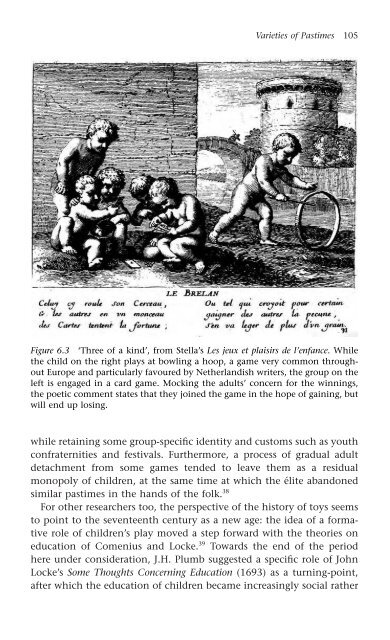Recreation in the Renaissance
Recreation in the Renaissance
Recreation in the Renaissance
- No tags were found...
Create successful ePaper yourself
Turn your PDF publications into a flip-book with our unique Google optimized e-Paper software.
Varieties of Pastimes 105<br />
Figure 6.3 ‘Three of a k<strong>in</strong>d’, from Stella’s Les jeux et plaisirs de l’enfance. While<br />
<strong>the</strong> child on <strong>the</strong> right plays at bowl<strong>in</strong>g a hoop, a game very common throughout<br />
Europe and particularly favoured by Ne<strong>the</strong>rlandish writers, <strong>the</strong> group on <strong>the</strong><br />
left is engaged <strong>in</strong> a card game. Mock<strong>in</strong>g <strong>the</strong> adults’ concern for <strong>the</strong> w<strong>in</strong>n<strong>in</strong>gs,<br />
<strong>the</strong> poetic comment states that <strong>the</strong>y jo<strong>in</strong>ed <strong>the</strong> game <strong>in</strong> <strong>the</strong> hope of ga<strong>in</strong><strong>in</strong>g, but<br />
will end up los<strong>in</strong>g.<br />
while reta<strong>in</strong><strong>in</strong>g some group-specific identity and customs such as youth<br />
confraternities and festivals. Fur<strong>the</strong>rmore, a process of gradual adult<br />
detachment from some games tended to leave <strong>the</strong>m as a residual<br />
monopoly of children, at <strong>the</strong> same time at which <strong>the</strong> élite abandoned<br />
similar pastimes <strong>in</strong> <strong>the</strong> hands of <strong>the</strong> folk. 38<br />
For o<strong>the</strong>r researchers too, <strong>the</strong> perspective of <strong>the</strong> history of toys seems<br />
to po<strong>in</strong>t to <strong>the</strong> seventeenth century as a new age: <strong>the</strong> idea of a formative<br />
role of children’s play moved a step forward with <strong>the</strong> <strong>the</strong>ories on<br />
education of Comenius and Locke. 39 Towards <strong>the</strong> end of <strong>the</strong> period<br />
here under consideration, J.H. Plumb suggested a specific role of John<br />
Locke’s Some Thoughts Concern<strong>in</strong>g Education (1693) as a turn<strong>in</strong>g-po<strong>in</strong>t,<br />
after which <strong>the</strong> education of children became <strong>in</strong>creas<strong>in</strong>gly social ra<strong>the</strong>r










